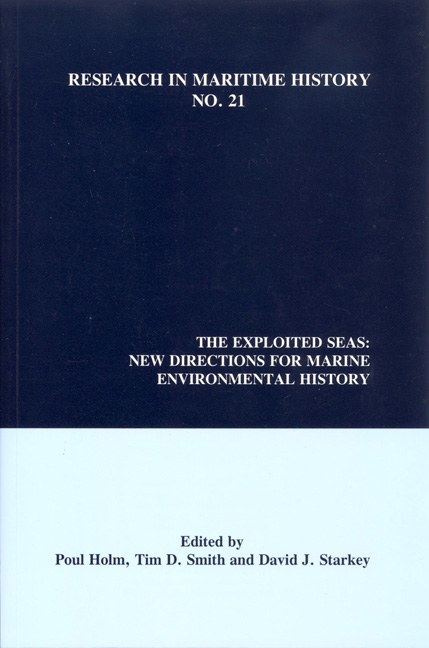Book contents
- Frontmatter
- Contents
- About the Editors
- Contributors
- “Introduction”
- Contributions
- “The Newfoundland Fisheries, c. 1500-1900: A British Perspective”
- “Testing Ecological Models: The Influence of Catch Rates on Settlement of Fishermen in Newfoundland, 1710-1833”
- “Nineteenth-Century Expansion of the Newfoundland Fishery for Atlantic Cod: An Exploration of Underlying Causes”
- “Status and Potential of Historical and Ecological Studies on Russian Fisheries in the White and Barents Seas: The Case of the Atlantic Salmon (Salmo Salar)”
- “The Danish Fisheries, c. 1450-1800: Medieval and Early Modern Sources and Their Potential for Marine Environmental History”
- “Historical Approaches to the Northern California Current Ecosystem”
- “Potential for Historical-Ecological Studies of Latin American Fisheries”
- “The South African Fisheries: A Preliminary Survey of Historical Sources”
- “The Potential for Historical Studies of Fisheries in Australia and New Zealand”
- “Examining Cetacean Ecology Using Historical Fishery Data”
“The Potential for Historical Studies of Fisheries in Australia and New Zealand”
from Contributions
- Frontmatter
- Contents
- About the Editors
- Contributors
- “Introduction”
- Contributions
- “The Newfoundland Fisheries, c. 1500-1900: A British Perspective”
- “Testing Ecological Models: The Influence of Catch Rates on Settlement of Fishermen in Newfoundland, 1710-1833”
- “Nineteenth-Century Expansion of the Newfoundland Fishery for Atlantic Cod: An Exploration of Underlying Causes”
- “Status and Potential of Historical and Ecological Studies on Russian Fisheries in the White and Barents Seas: The Case of the Atlantic Salmon (Salmo Salar)”
- “The Danish Fisheries, c. 1450-1800: Medieval and Early Modern Sources and Their Potential for Marine Environmental History”
- “Historical Approaches to the Northern California Current Ecosystem”
- “Potential for Historical-Ecological Studies of Latin American Fisheries”
- “The South African Fisheries: A Preliminary Survey of Historical Sources”
- “The Potential for Historical Studies of Fisheries in Australia and New Zealand”
- “Examining Cetacean Ecology Using Historical Fishery Data”
Summary
Abstract
This paper presents a preliminary appraisal of primary sources that might prove valuable in investigating the impact of human harvesting on fish populations off Australia and New Zealand. Since for most of their history the Australasian fisheries have been dominated by small family operations, few company records exist. This means that the major sources have been generated by government fisheries departments and other agencies, as well as by reports and proceedings of government inquiries. The paper focuses on printed statistical sources because further research is required to locate archival and other sources, especially in New Zealand. Secondary literature is also used to present an historical snapshot of Australian and New Zealand fisheries. The paper begins with an outline of the development of commercial fishing in both countries; then discusses statistical sources; and finally assesses their potential for the HMAP project. A case study of the Southeast Australian Trawl Fishery is also included; its main finding is that this important multi-species fishery will yield much evidence to test the hypotheses that lie at the core of the History of Marine Animal Populations project.
Introduction
In 1988, Giulio Pontecorvo made what he termed “a modest proposal” for an improved global fishery database to be administered by the Food and Agriculture Organisation (FAO) which would provide more complete information on the health of world fisheries. In particular, he called for more comprehensive time series on capital, labour, prices and stock assessments. This led to a debate about the costs and benefits of data collection and the need to ensure that data are collected “not just for the benefit of a few ivory tower academics.” Naturally enough, fisheries managers tend to have a narrower focus than scientists, economists and other scholars interested in marine animal populations. For example, in 1996, a review of the Australian Fisheries Management Authority (AFMA) concluded that there was insufficient information on stock levels, fishing effort and catch statistics to enable an accurate assessment of the Authority's effectiveness.
- Type
- Chapter
- Information
- The Exploited SeasNew Directions for Marine Environmental History, pp. 181 - 206Publisher: Liverpool University PressPrint publication year: 2001

